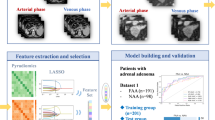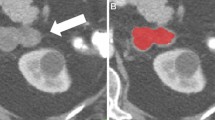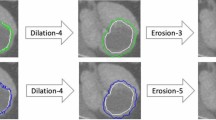Abstract
Adrenal abnormalities are commonly identified on computed tomography (CT) and are seen in at least 5 % of CT examinations of the thorax and abdomen. Previous studies have suggested that evaluation of Hounsfield units within a region of interest or a histogram analysis of a region of interest can be used to determine the likelihood that an adrenal gland is abnormal. However, the selection of a region of interest can be arbitrary and operator dependent. We hypothesize that segmenting the entire adrenal gland automatically without any human intervention and then performing a histogram analysis can accurately detect adrenal abnormality. We use the random forest classification framework to automatically perform a pixel-wise classification of an entire CT volume (abdomen and pelvis) into three classes namely right adrenal, left adrenal, and background. Once we obtain this classification, we perform histogram analysis to detect adrenal abnormality. The combination of these methods resulted in a sensitivity and specificity of 80 and 90 %, respectively, when analyzing 20 adrenal glands seen on volumetric CT datasets for abnormality.






Similar content being viewed by others
References
Mayo-Smith WW, Boland GW, Noto RB, Lee MJ: State-of-the-art adrenal imaging. Radiographics 21(4):995–1012, 2001
Blake MA, Krishnamoorthy SK, Boland GW, Sweeney AT, Pitman MB, Mueller PR, Hahn PF: Low-density pheochromocytoma on CT: a mimicker of adrenal adenoma. AJR Am J Roentgenol 181:1663–1668, 2003
Peña CS, Boland GW, Hahn PF, Lee MJ, Mueller PR: Characterization of indeterminate (lipid-poor) adrenal masses: use of washout characteristics at contrast-enhanced CT. Radiology 211(3):629–636, 2000
“Radiology Associates.” [Online]. Available: http://www.rasloimaging.com/for_physcians/Master Schedules/Newsletters/Feb.2012 Newsletter.pdf. Accessed 10 May 2012.
Yao C, Wada T, Shimizu A, Kobatake H, Nawano S: Simultaneous location detection of multi-organ by atlas-guided eigen-organ method in volumetric medical images. Int J CARS 1:42–44, 2006
Han X, Hoogeman MS, Levendag PC, Hibbard LS, Teguh DN, Voet P, Cowen AC, Wolf TK: Atlas-based auto-segmentation of head and neck CT images. Med Image Comput Comput Assist Interv 11(Pt 2):434–441, 2008
Zhuang X, Rhode K, Arridge S, Razavi R, Hill D, Hawkes D, Ourselin S: An atlas-based segmentation propagation framework using locally affine registration—application to automatic whole heart segmentation. Med Image Comput Comput Assist Interv 11(Pt 2):425–433, 2008
Pescia D, Paris ECD, Galen E, Saclay I, Sas I: Automatic detection of liver tumors. Biomedical Imaging From Nano to Macro 2008 ISBI 2008 5th IEEE International Symposium, 2008, pp. 672–675
Bosch A, Zisserman A, Munoz X: Image classification using random forests and ferns. IEEE 11th International Conference on Computer Vision, 2007, vol. 23, no. 1, pp 1–8
Moosmann F, Triggs B, Jurie F: Fast discriminative visual codebooks using randomized clustering forests. Adv Neural Inform Process Syst 19(3):985, 2007
Kontschieder PP, Rota Bulò S, Bischof H, Pelillo M: Structured class-labels in random forests for semantic image labeling. Computer Vision (ICCV), IEEE International Conference on Computer Vision (2011), vol. 13, no. 6 pp 2190–2197, 2011
Chipman HA, George EI, McCulloch RE: Bayesian ensemble learning. Transportation Research Part B: Methodological 44(5):686–698, 2007
Maree R, Geurts P, Piater J, Wehenkel L: Random subwindows for robust image classification. 2005 IEEE Computer Society Conference on Computer Vision and Pattern Recognition CVPR05, vol. 1, no. June, pp. 34–40, 2005
Shotton J, Johnson M, Cipolla R: Semantic texton forests for image categorization and segmentation. IEEE Conference on Computer Vision and Pattern Recognition (2008), vol. 259, no. 4 Pt 2, pp 1–8, 2008
Yin P, Criminisi A, Winn J, Essa I: Tree-based classifiers for bilayer video segmentation. 2007 IEEE Conference on Computer Vision and Pattern Recognition, 2007, pp 1–8
Criminisi A, Shotton J: Decision forests with long-range spatial context for organ localization in CT volumes. MICCAI Workshop on, 2009
Breiman L: Random forests. Mach Learn 45(1):5–32, 2001
Ho LM, Paulson EK, Brady MJ, Wong TZ, Schindera ST: Lipid-poor adenomas on unenhanced CT: does histogram analysis increase sensitivity compared with a mean attenuation threshold? AJR Am J Roentgenol 191(1):234–238, 2008
Korobkin M, Brodeur FJ, Yutzy GG, Francis IR, Quint LE, Dunnick NR, Kazerooni EA: Differentiation of adrenal adenomas from nonadenomas using CT attenuation values. AJR Am J Roentgenol 166(3):531–536, 1996
Szolar DH, Kammerhuber F: Quantitative CT evaluation of adrenal gland masses: a step forward in the differentiation between adenomas and nonadenomas? Radiology 202(2):517–521, 1997
Caoili EM, Korobkin M, Francis IR, Cohan RH, Platt JF, Dunnick NR, Raghupathi KI: Adrenal masses: characterization with combined unenhanced and delayed enhanced CT. Radiology 222(3):629–633, 2002
Song JH, Chaudhry FS, Mayo-Smith WW: The incidental indeterminate adrenal mass on CT (>10 H) in patients without cancer: is further imaging necessary? Follow-up of 321 consecutive indeterminate adrenal masses. AJR Am J Roentgenol 189(5):1119–1123, 2007
Song JH, Chaudhry FS, Mayo-Smith WW: The incidental adrenal mass on CT: prevalence of adrenal disease in 1,049 consecutive adrenal masses in patients with no known malignancy. AJR Am J Roentgenol 190(5):1163–1168, 2008
Hahn PF, Blake MA, Boland GWL: Adrenal lesions: attenuation measurement differences between CT scanners. Radiology 240(2):458–463, 2006
Blake MA, Kalra MK, Sweeney AT, Lucey BC, Maher MM, Sahani DV, Halpern EF, Mueller PR, Hahn PF, Boland GW: Distinguishing benign from malignant adrenal masses: multi-detector row CT protocol with 10-minute delay. Radiology 238(2):578–585, 2006
Blake MA, Slattery JMA, Kalra MK, Halpern EF, Fischman AJ, Mueller PR, Boland GW: Adrenal lesions: characterization with fused PET/CT image in patients with proved or suspected malignancy—initial experience. Radiology 238(3):970–977, 2006
Szolar DH, Korobkin M, Reittner P, Berghold A, Bauernhofer T, Trummer H, Schoellnast H, Preidler KW, Samonigg H: Adrenocortical carcinomas and adrenal pheochromocytomas: mass and enhancement loss evaluation at delayed contrast-enhanced CT. Radiology 234(2):479–485, 2005
Acknowledgments
We deeply convey our regards to Dr. Eliot Siegel, Director, Radiology, Baltimore Veterans Affairs Medical Center, Professor of Diagnostic Radiology and Nuclear Medicine, University of Maryland Medical Center, for his constant support, comments, and suggestions during this work.
Author information
Authors and Affiliations
Corresponding author
Rights and permissions
About this article
Cite this article
Saiprasad, G., Chang, CI., Safdar, N. et al. Adrenal Gland Abnormality Detection Using Random Forest Classification. J Digit Imaging 26, 891–897 (2013). https://doi.org/10.1007/s10278-012-9554-7
Published:
Issue Date:
DOI: https://doi.org/10.1007/s10278-012-9554-7




